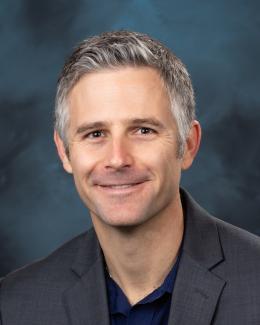
Bio
Michael B. R. Smith received his BS (2012-2016) and MS (2017) degrees in Nuclear Engineering from the University of Tennessee, Knoxville. His research focused on galactic cosmic ray effects on the Martian surface and radioisotope power system (RPS) radiation environments. During his studies, Michael worked as an intern at Oak Ridge National Laboratory (ORNL) at the Spallation Neutron Source (SNS) on the Personal Protection Systems team developing, authoring, and testing safety procedures for neutron beamlines before transitioning to the Neutronics team where he supported beamline diagnostics and facility-wide radiation background analysis. His final years at the university found him working as a graduate teaching assistant for the Department of Nuclear Engineering by day and captaining a 100 ton-class river boat by night.
He joined ORNL in 2017 in a post-Masters appointment where he worked in the Advanced Reactor Engineering Group supporting analysis for NASA's Radioisotope Power System Program and Nuclear Thermal Propulsion initiatives. Michael transitioned to staff at ORNL in 2018 where he continued to support analysis and research for the national space program. Michael currently works in the Systems Analysis and Optimization Group where he leads and supports multiple research and analysis activities with a focus on radiation modeling of spaceflight scenarios. These efforts primarily support NASA, Department of Defense, and industry activities to estimate and predict deleterious radiation environments. Modeling tools such as SCALE, MCNP, and HZETRN are used to model radiation environments created by onboard nuclear power and propulsion systems such as radioisotope power systems, nuclear electric propulsion, nuclear thermal propulsion, and fission surface power systems. These investigations also require understanding and simulation of natural radiation sources such as galactic cosmic rays, solar particle events, and trapped radiation belts.
Some of the recent nuclear space activities that Michael has led or supported are:
- Collaboration with the Southwest Research Institute comparing simulated surface radiation environments on Mars to the Mars Science Laboratory's Radiation Assessment Detector.
- Development of the Radioisotope Power System Dose Estimation Tool (RPS-DET).
- Providing radiation analysis for NASA's investigations into RPS-powered pressurized Lunar and Martian rover technologies.
- Providing radiation analysis for NASA's Mars Transportation Assessment Study (MTAS) for nuclear electric propulsion systems.
- Assessing radiation implications for NASA's dynamic radioisotope power system initiative.
- Providing subject matter expertise and radiation simulation support for Voyager I's Cosmic Ray Subsystem science team.
- Guiding analytical research for NASA's Planetary Protection Office to assess feasibility of radiation-induced bioburden reduction for interplanetary spacecraft.
- Actively support radiation-related inquiries for John Hopkins Applied Physics Laboratory's Dragonfly mission.
- Other Defense-related and business-sensitive industry projects.
Michael is also pursuing improved and immersive data visualization techniques. Coupling advances in gaming engine software with augmented reality technologies has opened an area of research for representing and interacting with radiation transport results. Michael led a competitively awarded, internal seed fund in 2020 which allowed the development and demonstration of a new immersive capability for experiencing, visualizing, and interacting with ionizing radiation data. The project is called Virtual Interaction with Physics Enhanced Reality (VIPER) and delivered a validated and verified immersive technology demonstration where a user can not only see ionizing radiation fields, but also receive real time behavioral feedback of their simulated radiation exposures without the consequence of actual exposure to radiation. This project has helped to not only demonstrate the feasibility of radiological augmented reality tools but has also attracted multiple follow-on research opportunities using augmented reality.
Prior to his career in the nuclear sector, Michael worked in the maritime industry in various capacities. Out of high school, Michael worked in the Bering Sea on commercial fishery vessels before transitioning to warmer climates (2001-2002). An interest in the underwater environment led him to pursue diving opportunities on the Northern Gulf Coast of Florida where he worked as a recreational PADI Divemaster, and salvage diver, along with supporting underwater reef installations and videography for the Okaloosa County Artificial Reef Association (2002-2004). Michael then attended the Marine Diving Technology (MDT) program in Santa Barbara, CA which included academic and practical instruction for commercial diving life support systems, surface supplied hard hat diving operations, mixed-gas bell diving, saturation diving, hyperbaric decompression systems, underwater inspections, underwater welding/burning, remote operated vehicles, underwater communication systems, crane operation, rigging, seamanship, and emergency medical training. During this academic period Michael also worked as a recreational Divemaster on charter vessels to the Channel Islands National Park and as a surface supplied commercial diver in Santa Barbara, CA providing underwater support for oil rigs, water treatment facilities, local municipalities, and the Santa Barbara Police Department (2004-2006). His next position was working as a manned-submersible pilot for the Canada-based tourist company, Atlantis Submarines, located at the Maui, HI office. After a two-year U.S. Coast Guard (USCG)-approved qualification and testing curriculum, he was issued a USCG Manned Submersible endorsement. Since then, Michael has logged over 1,000 subsurface hours as master (pilot), and 3,000 subsurface hours as crew (co-pilot) in the Atlantis IX and IV vessels off the coast of Maui, HI (2006-2011).
Awards
• The University of Tennessee’s Department of Nuclear Engineering Masters Graduate Research Excellence Award (2017)
• Member of the Alpha Nu Sigma National Honors Society (2016)
• Recipient of the Nuclear Regulatory Commission’s Academic Scholarship at The University of Tennessee (2015)
• Recipient of the SpectraTech Academic Scholarship at The University of Tennessee (2014)
• Recipient of the EdSouth Academic Scholarship at Pellissippi State Community College (2012)
• Recipient of the Ramsy Parks Academic Scholarship at the Marine Diving Technologies Program (2006)
Education
- Bachelors of Science, Nuclear Engineering - University of Tennessee, Knoxville (2016)
- Masters of Science, Nuclear Engineering - University of Tennessee, Knoxville (2017)
Trademarks and Patents
US10028492B2: "Methods and systems for maintaining a constant depth"

